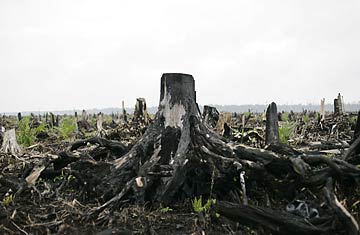
The Bush White House was so profoundly hostile to action on global warming that during its eight-year tenure, one could have qualified as a "green progressive" simply by asserting that climate change was real. In 2007, under these circumstances — perhaps because of them — was born an unlikely alliance between Duke Energy, a North Carolina-based utility that depends heavily on coal, and the Environmental Defense Fund, which together with 30 other green groups and major corporations, formed the U.S. Climate Action Partnership (USCAP).
USCAP called for a 42% reduction in U.S. carbon emissions by 2030 from 2005 levels, along with subsidies for coal plants that can capture CO2 and a market board to administer carbon offsets. And on Jan. 15, the leaders of USCAP — including GE head Jeffrey Immelt and DuPont chairman Charles Holliday — visited Capitol Hill to pitch their carbon-cutting blueprint. With Bush out of the way, it almost seemed likely. (See TIME's "Innovators of Renewable Energy")
"USCAP has redefined what is possible," said Jonathan Lash, the president of the World Resources Institute. "If the diverse membership of USCAP can find common ground, Congress can agree on effective legislation."
But without Bush, the climate-change movement is having to re-mobilize — that warming exists is not quite the provocative statement it once was — and the gaps in the armor are showing. USCAP's recommendations have recently come under attack from a number of outside environmental groups, and the National Wildlife Federation even dropped out of the alliance rather than endorse the blueprint. The problem is that USCAP would allow industry to pay for offsets of around 2 billion metric tons of CO2 a year, to ensure that business has plenty of time to make the transition to a low-carbon economy. (Offsets are projects in which companies pay to reduce carbon emissions more cheaply elsewhere, often by funding energy efficiency programs or through forestry, rather than cutting their own emissions.) But as the blogger and former Clinton Administration Energy Department official Joseph Romm has pointed out, total U.S. greenhouse gas emissions were 7.4 billion metric tons in 2005 — meaning that under USCAP, industry could get away with offsetting more than a 25% of total emissions.
Worse, many experts consider the offset system deeply flawed. A 2008 Stanford University study found that between one-third and two-thirds of carbon offsets under the U.N.'s Clean Development Mechanism — which oversees offset projects under the Kyoto Protocol — do not represent actual emission cuts. In addition, the USCAP proposal recommends that many of the initial carbon emission allowances under a cap-and-trade system should be given to industry free, rather than auctioned — even though auctioning would push carbon reductions faster. (President-elect Obama has said he's in favor of auctions.) "The proposal is a dead end — and an even deader starting point," writes Romm. (Read "Obama Cleans Up After Bush.)
Others would argue there's value in getting giant corporations on board with carbon caps, even if it means offering them a watered-down proposal. But even that may be onerous: As difficult as it was convincing the public that climate change was a clear and present danger — and a majority of conservatives are still doubtful — the political fight to really cut carbon emissions will be knottier. Although Obama has surrounded himself with scientists who believe that global warming is our biggest threat — including Nobel Prize-winner Steven Chu as Energy Secretary, and Harvard's John Holdren as White House science adviser — members of the President-elect's economic team reportedly remain doubtful that cutting carbon is worth the money. And even though Obama has pledged to listen to his scientists "even when it's inconvenient — especially when it's inconvenient," it's the economy that remains front and center in the public realm. (Read "Despite the Economy, Obama Vows to Press Green Agenda.")
Meanwhile the science on climate change grows more dire. James Hansen, NASA's climate expert, reported in a recent paper that the world needed to stabilize carbon in the atmosphere at 350 parts per million (ppm) to avoid the worst effects of warming — a more stringent goal than earlier estimates, which had a target of 450 ppm. (The current concentration is 385 ppm and rising fast, up from a pre-industrial level of 280 ppm.) That would require action that is far more ambitious than currently seems possible — both in the U.S. and in the developing world, where the bulk of new carbon emissions will come. Even under Obama, the politics of climate change isn't keeping up with the science.
So, where does that leave the green movement's prospects? "I don't think we can afford the luxury of pessimism or optimism," says Tim Flannery, an Australian scientist and the head of the Copenhagen Climate Council. "It's time to work." But under Obama, environmentalists can't just settle for acts that feel good — this time, they have to deliver the goods.
